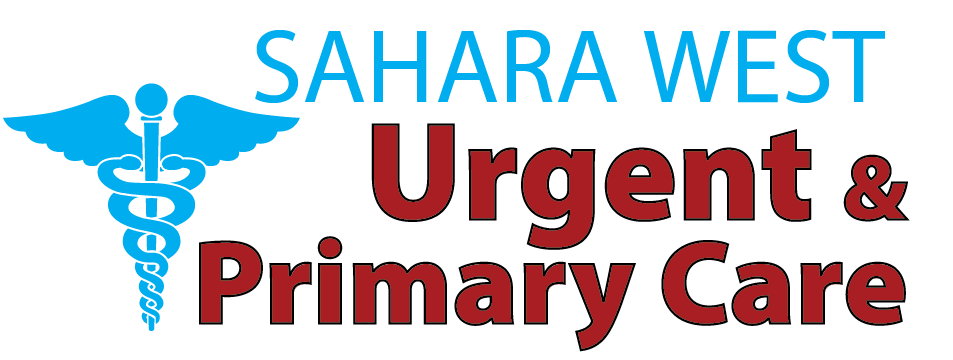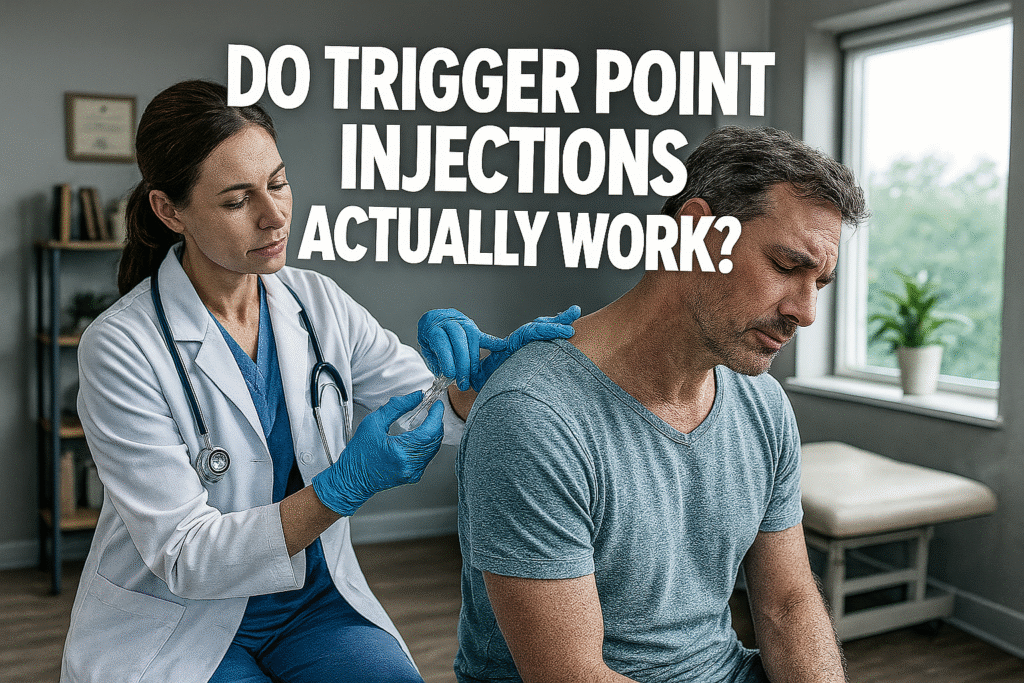Millions of people suffer from chronic muscle pain and stiffness because of tight knots in the muscles, known as trigger points. In the worst case, there may be severe discomfort and possibly an irradiation of pain to other parts of your body at these small, tender areas. To relieve you of this, doctors will give you a trigger point injection, which is a method to get rid of the pain and for better movement.
But do they really work? We will discuss the science, the process, and what patients can reasonably expect from these injections.
What Are Trigger Points?
Definition and Physiology
Trigger points are knots or hyper-irritable nodules that develop in the skeletal muscles. They are seen when the muscle cells are in contraction, leading to blood loss and localized pain. These points may give referred pain when pressed – pain experienced in some other part of the body.
Common Locations & Symptoms
Trigger points commonly occur in the neck, shoulders, back, and hips. Symptoms often include:
- Persistent muscle tightness
- Local tenderness or swelling
- Limited range of motion
- Headaches or radiating pain patterns
Understanding where and how trigger points develop helps explain why trigger point injections are used to target and deactivate them.
What Is a Trigger Point Injection?
Components (Local Anesthetic, Saline, Steroid, Dry Needling)
A trigger point injection involves inserting a fine needle into the affected muscle area. The injection may contain:
- Local anesthetic (e.g., lidocaine) to numb the pain
- Saline solution to break up muscle fibers
- Corticosteroid to reduce inflammation
In some cases, the procedure is done without medication (dry needling).
Procedure: Step-by-Step
- The doctor locates the trigger point by palpating the muscle.
- The area is cleaned and sterilized.
- A thin needle is inserted directly into the knot.
- The medication is injected, and the needle is removed.
- The patient may be asked to stretch or move the muscle afterward.
This procedure usually takes less than 15 minutes and can provide rapid relief.
The Proposed Mechanisms: How They Might Work
Muscle Relaxation & Fascia Release
Trigger point injections serve to relax the tight muscles and enhance the flow of blood in the area. The needle itself may interfere with the contracted band of muscle, and it may revert to a normal one.
Interrupting Pain Signals
The anesthetic is a temporary block of pain receptors, which breaks the loop of pain and muscle spasm – this allows the brain to have a temporary reset of the pain reaction.
Local Chemical Changes
Injections may also aid in clearing out inflammatory chemicals such as substance P and cytokines that are the cause of pain and sensitivity.
Review of the Scientific Evidence
Systematic Reviews & Meta-Analyses
The studies on the use of trigger point injections in Las Vegas have mixed but generally positive outcomes. Meta-analyses indicate a substantial decrease in pain in the short term as compared to the placebo or dry needling.
Randomized Controlled Trials
The clinical trials suggest that local anesthetic injections are more effective than dry needling alone in terms of immediate relief and especially for myofascial pain syndrome.
Case Series & Observational Studies
Due to the condition, the method of injection, and adherence to rehabilitation programs, long-term outcomes are different.
Effectiveness: What Clinical Outcomes Show
Pain Reduction
Due to the condition, the method of injection, and adherence to rehabilitation programs, long-term outcomes are different.
Functional Improvement
Injections help to restore the range of motion and ease physical therapy or exercise, which is vital in the long-term recovery.
Duration of Relief
Results vary: some people need only one session, while others benefit from periodic injections combined with stretching and posture correction.
Which Conditions Respond Best?
Myofascial Pain Syndrome
30 This is the most frequent indication. Chronic painful muscle knots also generally respond well.
Neck, Shoulder, Back Pain
Injections of a trigger point in these regions can be useful to help reduce tension and alleviate pain that results from long hours of sitting or poor posture.
Headache / Migraine
INJECTIONS FOR TENSION HEADACHES OR CERVICOGENIC MIGRAINES Injections aimed at upper back or neck trigger points have been demonstrated to lower the rate of tension headaches or cervicogenic migraines.
Fibromyalgia & Other Syndromes
Although the sensation of pain may be widespread in fibromyalgia, treatment that targets tender spots similar to TP therapy can facilitate the reduction of localized sensitive areas and make it more comfortable or easier to hydrate tissue.
Factors Influencing Success
Injection Technique & Experience
Outcomes rely on the clinician’s acumen in palpating active trigger points. Since the success rate of this method increases with experience, an experienced operator produces a higher yield.
Patient Selection & Co-morbidities
Recurrence is frequent in patients who have stress, anxiety, or poor posture habits. Addressing underlying causes improves outcomes.
Adjunct Therapies (Physio, Stretching, Massage)
In addition to physical therapy, heat therapy, and ergonomic correction, trigger point injections provide long-term benefits.
Risks, Side Effects & Contraindications
Common Mild Reactions
- Temporary soreness
- Bruising
- Mild bleeding
- Dizziness or fatigue
Rare Complications
Serious side effects are uncommon but may include infection, allergic reaction, or nerve injury.
When NOT to Use Trigger Point Injections
Patients with bleeding disorders, infections at the injection site, or certain medication allergies should avoid this treatment.
Trigger Point Injections vs Other Treatments
Dry Needling & Acupuncture
Dry needling does not involve medication and is based on mechanical stimulation. Both treatments work, but injections may offer more immediate pain relief.
Physical Therapy & Manual Therapy
Physical therapy focuses on muscle re-education, and the injections offer instant pain control — both of them should be done together for best results.
Medications & Other Injections
Oral pain medication or nerve blocks may be used in combination with trigger point injections (for chronic pain management).
Patient Experience: What to Expect
Pre-injection Preparation
Patients should avoid blood thinners and eat lightly before the procedure.
During the Procedure
Mild discomfort or twitching may occur as the needle hits the trigger point — this is a normal “release” response.
Post-injection Care & Recovery
Light stretching, hydration, and gentle massage are encouraged. Avoid heavy activity for 24 hours.
Cost, Insurance & Accessibility
Typical Costs
Prices differ from place to place/ provider $50 – 300 per session is a common price for TMS.
Insurance Coverage & Reimbursement
When given by a doctor, trigger point injections are usually paid for by insurance, including Medicare.
Where to Get the Best Provider
This is often provided through pain clinics, physiatrists, and sports medicine physicians.
Examples / Success Stories from the Field
A lot of patients say that TP injections helped get them back to work, off some meds, and back into regular activities. Office workers with neck pain, for instance, frequently find immediate relief that can endure weeks or months.
Implications for Research and Knowledge Gaps
There is evidence for the relief of short-term pain; however, there is a lack of high-quality research to determine long-term effects and optimal treatment regimens. Results are varied due to differences in the technique and patient factors.
Conclusion
Done properly, quite effective for treating muscle pain are trigger point injections. They offer quick relief, minimal downtime, and excellent results when used in conjunction with physical therapy and lifestyle changes.
If you are suffering from these tight knots or they result in chronic pain, consult an experienced Pain Management Physician to determine whether Trigger Point injections are the right treatment for you. To schedule your appointment with the highest standard of care, visit Sahara West Urgent Care on our website, where you can also explore more informative blogs





